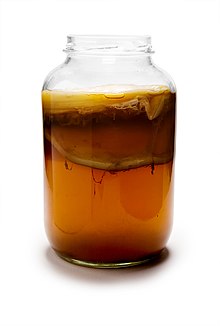
Back كومبوتشا Arabic كومبوتشا ARZ Чайны грыб Byelorussian Комбуча Bulgarian Kombutxa Catalan Kombucha Czech Kombucha Welsh Kombucha Danish Kombucha German Κομπούχα Greek
 Kombucha tea, including the culture of bacteria and yeast, which is not usually consumed | |
| Type | Flavored cold tea drink with fermentation byproducts |
|---|---|
| Country of origin | China |
| Alcohol by volume | <0.5% (commercial) |
| Proof (US) | <1 (commercial) |
| Color | Cloudy, commonly pale or dark brown and sometimes green |
| Flavor | Fermented, effervescent |
| Ingredients | Tea, sugar, bacteria, yeast |
| Variants | Fruit juices or spices added |
| Related products | Water kefir, kefir, kvass, beer, iced tea |
Kombucha (also tea mushroom, tea fungus, or Manchurian mushroom when referring to the culture; Latin name Medusomyces gisevii)[1] is a fermented, lightly effervescent, sweetened black tea drink. Sometimes the beverage is called kombucha tea to distinguish it from the culture of bacteria and yeast.[2] Juice, spices, fruit or other flavorings are often added.
Kombucha is thought to have originated in China, where the drink is traditional.[3][4] By the early 20th century it spread to Russia, then other parts of Eastern Europe and Germany.[5] Kombucha is now homebrewed globally, and also bottled and sold commercially.[1] The global kombucha market was worth approximately US$1.7 billion as of 2019[update].[6]
Kombucha is produced by symbiotic fermentation of sugared tea using a symbiotic culture of bacteria and yeast (SCOBY) commonly called a "mother" or "mushroom". The microbial populations in a SCOBY vary. The yeast component generally includes Saccharomyces cerevisiae, along with other species; the bacterial component almost always includes Gluconacetobacter xylinus to oxidize yeast-produced alcohols to acetic acid (and other acids).[7] Although the SCOBY is commonly called "tea fungus" or "mushroom", it is actually "a symbiotic growth of acetic acid bacteria and osmophilic yeast species in a zoogleal mat [biofilm]".[1] The living bacteria are said to be probiotic, one of the reasons for the popularity of the drink.[8][9]
Numerous health benefits have been claimed to correlate with drinking kombucha;[10] there is little evidence to support any of these claims.[8][10][11] The beverage has caused rare serious adverse effects, possibly arising from contamination during home preparation.[12][13] It is not recommended for therapeutic purposes.[10][14]
- ^ a b c Cite error: The named reference
Jayabalanwas invoked but never defined (see the help page). - ^ "A mug of kombucha for your health?". Mayo Clinic. Retrieved 1 September 2018.
- ^ "kombucha | Description, History, & Nutrition". Encyclopedia Britannica. Retrieved 20 April 2021.
- ^ Alex., LaGory (2016). The Big Book of Kombucha. Storey Publishing, LLC. p. 251. ISBN 978-1-61212-435-3. OCLC 1051088525.
- ^ Troitino, Christina. "Kombucha 101: Demystifying The Past, Present And Future Of The Fermented Tea Drink". Forbes. Retrieved 10 April 2017.
- ^ Cite error: The named reference
big-kombuwas invoked but never defined (see the help page). - ^ Jonas, Rainer; Farah, Luiz F. (1998). "Production and application of microbial cellulose". Polymer Degradation and Stability. 59 (1–3): 101–106. doi:10.1016/s0141-3910(97)00197-3.
- ^ a b Bauer, Brent (8 July 2017). "What is kombucha tea? Does it have any health benefits?". Mayo Clinic. Retrieved 5 September 2018.
- ^ Wollan, Malia (24 March 2010). "Kombucha Tea Attracts a Following and Doubters". The New York Times. Retrieved 5 September 2018.
- ^ a b c Cite error: The named reference
Ernst2003was invoked but never defined (see the help page). - ^ Kapp, J. M.; Sumner, W. (2019). "Kombucha: a systematic review of the empirical evidence of human health benefit". Annals of Epidemiology. 30. Elsevier: 66–70. doi:10.1016/j.annepidem.2018.11.001. PMID 30527803. S2CID 54472564.
- ^ Cite error: The named reference
mskccwas invoked but never defined (see the help page). - ^ Cite error: The named reference
acswas invoked but never defined (see the help page). - ^ Bauer, Brent. "What is kombucha tea? Does it have any health benefits?". Mayo Clinic. Retrieved 28 May 2020.